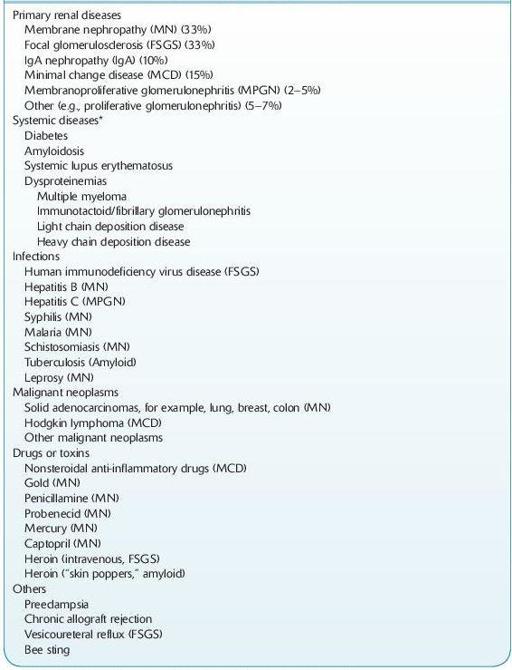Wallach's Interpretation of Diagnostic Tests: Pathways to Arriving at a Clinical Diagnosis (543 page)
Authors: Mary A. Williamson Mt(ascp) Phd,L. Michael Snyder Md

BOOK: Wallach's Interpretation of Diagnostic Tests: Pathways to Arriving at a Clinical Diagnosis
3.56Mb size Format: txt, pdf, ePub
Focal nephritic: generally associated with inflammatory regions in less than one half of glomeruli. Patients often present with asymptomatic hematuria and proteinuria.
Diffuse nephritic: heavy proteinuria, edema, and hypertension may be observed.
Causes
Renal: can be postinfectious (due to certain nephritogenic strains after streptococcal, staphylococcal, or pneumococcal infections, mumps, measles, chickenpox, hepatitis B and C) or due to MPGN or anti–glomerular membrane disease.
Systemic: due to SLE, vasculitides, IgA nephropathy, or Henoch-Schönlein purpura.
Laboratory Findings
Urinalysis: oliguria (<400 mL/day), proteinuria (usually <3.5 g/day), and hematuria, with RBC casts.
Uremia and azotemia.
Complement C3 level is usually decreased. Immunologic tests (e.g., anti-GBM antibodies, ASO) can help in the differential diagnosis.
Renal biopsy establishes the diagnosis.
NEPHROTIC SYNDROME
This syndrome presents as heavy proteinuria, hypoalbuminemia, hyperlipidemia, lipiduria, and edema.
Causes
Primary glomerular diseases are responsible for >50% of all nephrotic syndrome cases. Systemic diseases such as diabetic glomerulosclerosis, SLE (14% of all cases), and amyloidosis (6% of cases) can also be associated with nephrotic syndrome. Other causes include infections, neoplasms (10% of adult cases), and drugs or toxins (see Table
12-5
).
TABLE 12–5. Major causes of Nephrotic Syndrome

Other books
1.4 by Mike A. Lancaster
The Good Die Twice by Lee Driver
Death Screams by Tamara Rose Blodgett
Smooth Operator (Teddy Fay) by Woods, Stuart, Hall, Parnell
Chosen: Book 1 in the Ancients of Light series by Heather Fleener
Lafferty, Mur by Playing for Keeps [html]
Reed (The Love Family Series Book 4) by Allenton, Kate
First Verse (Second Verse Book 1) by Snow, Emily
House of Cards by Michael Dobbs
Give It All by Cara McKenna